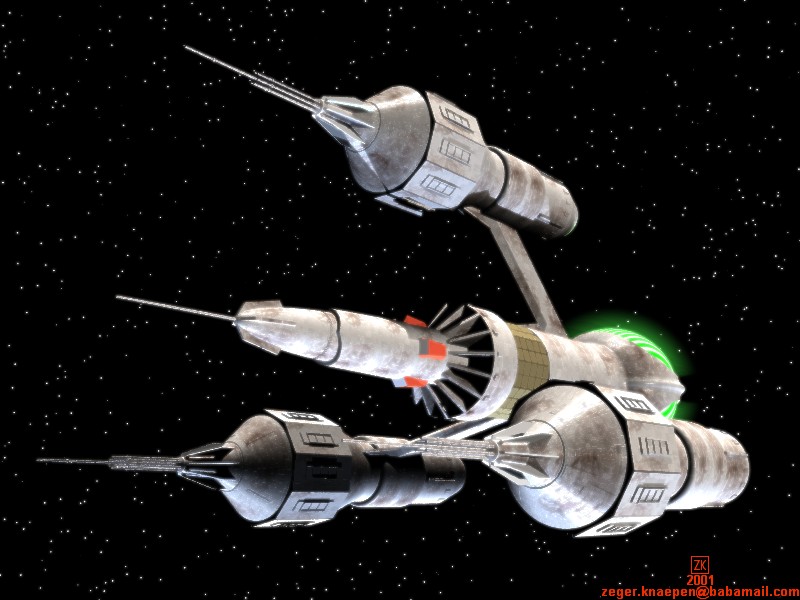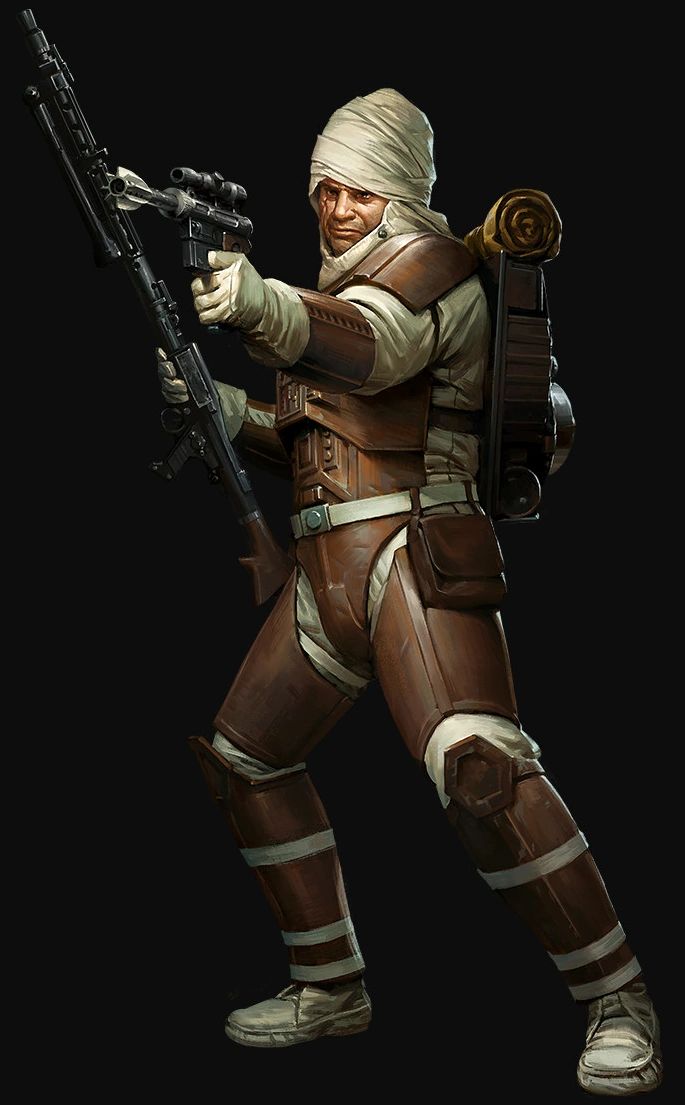 The Liberator
Craft: The Liberator (DSV2/Deep Space Vehicle 2)
Type: The System's Deep Space Battlecruiser
Scale: Capital
Length: 1,000m
Skill: Capital Statship Piloting; Liberator (or DSV)
Crew: 1,000, gunners: , skeleton: /+0 (Zen)
Crew Skill: Astrogation 4D, Capital Ship Gunnery 5D+2, Capital Ship Piloting 5D, Capital Ship Shields 4D+1, Sensors 5D
Zen's Skill: Astrogation 4D+2, Capital Ship Gunnery 4D+2, Capital Ship Piloting 4D+2, Capital Ship Repair 8D, Capital Ship Shields 4D+2, Sensors 5D (can operate ship's systems and weapons when lacking crew)
Passengers: 500 (troops)
Cargo Capacity: 50,000 metric tons
Consumables: 1 year (full crew), or 1,000 years (crew of 1)
Cost: N/A
Hyperdrive: x1/2 (Backup: x5)
Nav Computer: Yes
Maneuverability: 4D
Speed: 10
Hull: 8D (Herculanium)
Defenses:
-Shields (Force Wall): 4D (drains 1 pip per round from shields and weapons while active)
-Deflector Shields: 3D sensor jamming (see below)
-Psychic Security System (see below)
Sensors: (also used for the Teleporter)
Passive: 40/1D
Scan: 60/2D
Search: 120/3D
Focus: 5/4D
WEAPONS
3 Neutron Blaster Cannons (fire-linked)
Location: mounted on forward nacelles
Fire Arc: front
Crew: 1 (bridge crew)
Skill: Capital Ship Gunnery
Scale: Capital
Fire Control: 3D
Space Range: 3-10/25/50
Atmosphere Range: 300-1/2.5/5km
Damage: 12D (10D if not fire-linked)
Ammo: N/A
Rate of Fire: 1 (must recharge 1 round per gun (3 rounds) after every shot, OR fire at -1D Damage for every shot per round)
Special: If the radiation flare shields are not put up before firing the cannons, the ship takes full damage, as well as giving the crew harmful radiation poisoning.
9 Plasma Bolt Cannons
Location: scattered about the hull
Fire Arc: partial turrets; 3 right, front, left; 3 rear, left, front; 3 rear, right, front
Crew: 1; or Zen
Skill: Starship Gunnery
Scale: Starfighter
Fire Control: 2D
Space Range: 1-3/12/24
Atmosphere Range: 50-300/1.2/2.4km
Damage: 7D
Ammo: N/A
Rate of Fire: 1 (plasma bolt per attack)
6 "Seeker" Missile Launchers
Location: scattered about the hull
Fire Arc: 3 front; 3 turrets
Crew: 1; or Zen
Skill: Missile Weapons
Scale: Capital
Fire Control: 2
Space Range: 1/3/7
Atmosphere Range: 50-100/300/700m
Damage: 8D
Ammo: 10 missiles per launcher
Rate of Fire: 1 (missile per attack per launcher; OR volleyfire)
Special: Homing Missiles, these have 4D to retarget enemies if they miss
DESCRIPTION:
The Liberator was a deep space battle cruiser, equipped with powerful weapons, force field protection, and a system of "battle computers". The ship was originally built by a race of beings known as "The System". The System referred to the ship as DSV2 ("Deep Space Vehicle 2"), a designation that suggests it was specifically designed for long-range forays outside the territory controlled by The System, and confirming more than one such ship had ever been made. It had at least one sister ship, which was destroyed by Orac in the episode "Redemption". It was never clarified if the sister ship that Roj Blake encountered was DSV1.
The ship was controlled by an advanced AI computer calling itself Zen (Knowledge 4D, Mechanical 4D, Technical 4D, negates increased skill difficulties for skeleton crew), although it is not clear whether this was the computer's official name under The System, or whether Zen later chose this name for itself. During the episode "Redemption" the System's controllers, (referred to as "Altas"), had boarded the ship and also referred to the computer as Zen.
DSV2 first appeared in the series after it was involved in a space battle, (of which no further details were ever given), and apparently abandoned by its crew as a result of severe battle damage. It was demonstrated later in the series that temporary abandonment of the ship may be necessary until the auto-repair systems can restore life support after serious damage. DSV2 was encountered by the Federation prison ship London. The captain of the London decided to try to salvage the ship, but the first few crew members sent in were killed or disabled by DSV2's automated defence systems. At the suggestion of his second-in-command, the London's captain then ordered the prisoners Roj Blake, Kerr Avon, and Jenna Stannis to enter the ship. These three succeeded in taking control of the ship and making good their escape.
The name Liberator was then applied to the ship by Zen based on a telepathic suggestion by Jenna. Blake proceeded to use Liberator's superior technical abilities in his bid to attack and defeat the Federation until he disappeared during the battle of Star One. Avon then took over command of the Liberator and continued to harass the Federation until Liberator was destroyed after passing through a cloud of corrosive micro-organisms in the third season final episode "Terminal".
CONTROL SYSTEMS
Liberator was controlled, by and large, by the computer system called "Zen". Zen had master control over all of the ship's functions and acted as a coordinating central point for the crew on board. Zen typically relayed ship status and information from the detector arrays and contained a vast archive of navigational data. Zen was normally voice activated, but it could also gather information via telepathy, although it only used this latter ability after it had read Jenna's mind (when she touched a control console for the first time, as part of its internal defence system). Zen however, could be less than helpful at times and usually gave the "silent treatment" if it disagreed with the crew's commands or attitudes.
If need be, Zen could be overridden on certain functions, however because the Liberator was such a complex ship, without Zen's precise balance, the ship could easily go out of control (Maneuverability AND Weapons Fire Control 0D if not using Zen). Orac had the ability to take over computers with processors called "tarial cells" and was able to take control of Zen suggesting Zen used similar devices. Orac was also essential in deleting the System's "root access" to Zen and the Liberator's computers which had been used to retake the Liberator for a short time. Throughout its life, Zen never made reference to itself in the first person until it was failing under the corrosion onslaught in "Terminal" in which its last words were "I have failed you. I am sorry. I ..."
OFFENSIVE/DEFENSIVE SYSTEMS
Liberator was armed with three powerful neutron blaster cannons with one cannon mounted at the end of each of the three nacelles (turrets or pylons). The weapons were so powerful that a radiation flare shield had to be raised before activation to protect the crew and most targets were vaporized with a single hit. The ship could also fire plasma bolts and a salvo of "seeker" missiles which could decimate planet-side ground targets. Liberator's hull was covered with a material called "herculanium" which was impervious to almost all but the heaviest weapon fire. Liberator could easily withstand the assault of several warships before taking serious damage. Herculanium was explained as an alloy, but also referenced as an element.
Using technology on board the Liberator, Avon developed a practical "detector shield" for the ship by the episode "Trial". The shield made Liberator effectively invisible to any sensors save for a close range visual scan, allowing Blake to make a daring attack on the Federation's military headquarters space station causing extensive damage before the defending ships could respond.
By the time of episode "Hostage", The Federation had apparently copied Avon's idea, (at least a limited form), using it to launch a massive attack on the Liberator with upwards of twenty pursuit ships. Liberator was pounded with at least ten plasma bolts in rapid succession, but her superior speed let her break out of their attack pattern and retreat, albeit with severe damage to her defences. The Liberator was also equipped with a defensive "force wall" capability, but its usage resulted in a heavy drain on the energy banks (as did the extensive use of the neutron blasters).
SECURITY SYSTEM
Liberator was protected by a telepathic security system which was the first device encountered by Blake, Jenna and Avon before they could take control of the ship. Seen used on the flight deck, the system projected a mental image of someone the target trusted, or loved. In Blake's case, he saw members of his murdered family and friends. In creating the images, the system attempted to lure the target closer to a deadly sphere of energy (wllpower difficulty of Very Difficult, lowered to Difficult if image isn't 'right', 7D Damage). Blake remembered that his family was executed and didn't believe what he was seeing. As a result, he blasted the images with his weapon which disabled the security system. Prior to this, the system managed to kill almost all the London crew sent aboard to seize the ship.
TELEPORT
To use this device, the Sensors are required to get a target lock of where the crew wish to send themselves. If there is opposition against the teleport, it can be an enemy using jamming equipment (their Communications against the crew's Sensors), or if trying to board another ship, they could also do a Dodge against the crew's Sensors to shake off the target lock. The Teleporter has a 'Fire Control' of 2D or 4D (depending on if it is in Scan or Focus Sensor range) instead of the Sensor's Dice, and if not in a stationary orbit above a planet or near another ship or other stellar body (in other words, if the target is moving), then the ship must be within Scan or Focus Sensor range.
The ship was also equipped with a valuable matter teleportation system (similarly used like the transporters in the Star Trek series), a technology which the Federation was trying to develop on their own without success. Blake indicated that the device sends matter along energy signals similar to radio waves. Little was known about the technology itself.
The teleport system was located in a small room and consisted of a slightly elevated platform and a large control console for setting teleport coordinates and activating the system. The teleport created a shimmering effect on the subject which quickly faded away. Arrival off-ship produced a white glowing field visible only at its periphery that converged into an outline of the subject inside of which the subject materialized before the field would fade away. The process is reversed when teleported to the ship: a field surrounds the subject, the subject fades, the field suddenly expands, and the subject shimmers back into the teleport bay.
Teleported personnel had to wear a bracelet device to leave and return to the ship. The bracelets also served as communicators and contained a material called Aquitar (or "something similar" as indicated by Blake), which was believed to be necessary for the teleport to function.
Although Servalan had captured some of these bracelets, the teleport required the machinery aboard the Liberator to function. Likewise, unworn bracelets will not teleport without being attached to someone. There were at least twenty bracelets on the Liberator, and eleven of them were lost, destroyed or damaged throughout the series. However, the Liberator was evidently capable of creating more as a full bank of 28 bracelets was shown in "Redemption". The teleport signal could be blocked by energy screens and electronic jamming equipment. Usually the signal simply had to be adjusted outside the frequencies of such devices in order to get through (roll Sensors against enemy's jamming/Communications skill, higher roll wins).
Although the Liberator had a hangar bay, she carried no shuttle craft and gave no outward appearance of an ability to land, suggesting the teleport as a necessary piece of equipment. However, in the episode "Moloch", Zen declared, "Forward navigation probes report approach speed inconsistent with safe planetfall," as the ship nearly collided with the cloaked meteoroid Sardos, suggesting that safe "planetfall" was possible given the proper conditions.
The closest evidence of the ship ever "landing" was "Dawn of the Gods" in which it was gravitationally held on an artificial floor by the being called Tharn who sought to drain the ship of herculanium alloy for his gravity generator. The Liberator was properly docked when recovered by the System within a hangar in "Redemption", where approach and departure were depicted with an aircraft runway at night on the main screen. The third closest landing was in "Ultraworld" where the ship was conveyed into a hanger and restrained by huge metal bars interlocking between the nacelles and the main hull. The Liberator's power and structural integrity was sufficient to break out of this restraint and escape.
There is no evidence that she successfully landed or took off from a planetary surface.
POWER AND DRIVE SYSTEMS
(the stats given above for speed and hyperdive are an attempt to fit this ship into the Star Wars RPG system, and do not accurately fit the explanation below from the Blake's 7 series)
Liberator has a continuously recharging antimatter power supply that supposedly would last forever without the need of fuel. However, if the ship operated with every system activated it would drain the power supply down within two hours causing shut down until sufficient power was recharged.
The ship could repair itself when damaged. During such critical repair times, Zen would prioritize the survival of the Liberator over the well-being of the crew, going so far as to deactivate life support in order to reroute power to repair devices (this happens when Severe Damage is rolled on the Starship Damage chart). The auto-repair systems themselves would even attack anyone trying to keep them from their work.
Liberator's main drive consisted of a dimensional engine with ultralight speed capability; speeds were always stated in the form "standard by...", followed by the relevant number to multiply the "standard" Liberator speed by. It was never specified in the series what the "standard" speed was. In "Space Fall" when the new crew tell Zen they want a course for Cygnus Alpha, and Zen asks for the speed, Blake's answer is half a question. "Standard?"
The Federation used a "time distort" scale, but this term was never a term used by Zen or the Liberator's crew. Cally believed the ship could easily achieve a velocity of "standard by 12" and was considered one of the fastest ships in the galaxy. In the episode "Harvest of Kairos", the Liberator scanned a ship resembling a lunar module and, sensing a slightly more advanced ship due to Avon's artificial sopron, declared it to be capable of "Standard by twelve point two zero three", suggesting Liberator's capacity to be slightly below that. In the episode "Hostage", Liberator engaged with a fleet of Federation ships was observed accelerating away at a speed of TD-20. The fastest known Federation pursuit ships of the Starburst class had a known maximum (emergency) speed of TD-10 and the Liberator could easily outrun them. Standard by 6 became the Liberator's standard cruising speed in deep space. Speeds of less than TD-0 were considered sub-light speeds.
It appears that the Time Distort scale was exponential so that 'Standard by 12' equalling TD-20 would have been far in excess of double TD-10.
CREW EQUIPMENT AND AMENITIES
Personal weapons were also available aboard the ship. A weapons locker on the flight deck contained alien designed laser weapons (standard blaster types, 4D pistols, 5D rifles) and recharge equipment. The weapon locker would only allow a character to handle one weapon at a time. If they tried to grab a second while already equipped with one, the handle of the second weapon would become too hot to touch (3D Damage) (although once removed from the locker, weapons could be handed to other crew members without this effect occurring). This heat effect also prevented the crew from arming themselves for defense against the ship being seized by The System in "Redemption".
Liberator could function as a self-contained habitat and carried enough food supplies to last one "human" a thousand years, as Avon learned when he was contemplating stealing the ship for himself and going into hiding. The ship also recycled waste with 100% efficiency.
Liberator had at least five cargo holds plus a vast "strongroom" vault containing riches estimated (by Avon) to equal 300 million Federation Credits. Other areas contained a landing bay and hangar, an advanced surgical bay with resuscitation capsules (can bring a crew back from death if the damage was not too severe and if done within an hour after death), and a vast wardrobe filled with human-tailored outfits. The ship was also equipped with numerous emergency "life rockets" (aka escape pods); however, many of them had been launched by its previous crew prior to Blake's team taking possession of the ship. The number and positioning of these pods suggests that many had been replaced by the auto-repair system.
Although the crew of six people with help of Zen were able to operate the ship, the full stock of 28 teleport bracelets and the available number of handguns along with the sheer size of the ship (it could be resolved in low orbit by the naked eye from the ground) suggests the Liberator was intended to carry a much larger crew, but the total capacity remains unknown.
|












